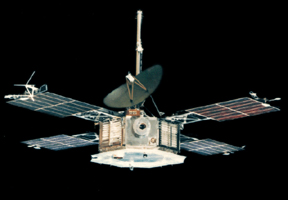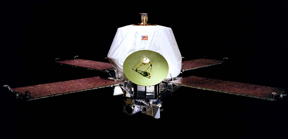Mariner (1962-1975)
Mariner | Pioneers | Voyagers | Other
Mars Missions | Galileo

The Mariner mission was a space program in the 1960's whose
purpose was to visit the inner solar system and
the three planets other than Earth: Mercury, Venus,
and Mars.
Mariner 2, in December of 1962, was the first successful probe
to flyby Venus. It confirmed that Venus' surface temperature was very hot (it
read about 800 °F, which has been revised to 900 °F - hot enough to melt
lead). This disproved the previous theory that there were oceans on Venus. It
also confirmed that Venus was cloud-covered, and that its atmosphere was comprised
mostly of carbon dioxide (CO2).
Mariner 3 was destined for Mars on November 5, 1964, but it
was lost when its protective shield failed to eject. It was unable to use its
solar panels to collect energy, because the shield failed to eject, so its batteries
soon died out. It is now in solar orbit.
 Mariner
4 was the sister probe of Mariner 3. It reached Mars in 1965 and took the first
21 pictures ever taken close-up of Mars. It showed that Mars was heavily cratered
and had a thinner atmosphere that previously thought. Most scientists concluded
that Mars was dead geologically and biologically from these initial scans. Mariner
4 was the sister probe of Mariner 3. It reached Mars in 1965 and took the first
21 pictures ever taken close-up of Mars. It showed that Mars was heavily cratered
and had a thinner atmosphere that previously thought. Most scientists concluded
that Mars was dead geologically and biologically from these initial scans.
Mariner 5 is pictured to the right.
Mariner 6 and 7, twin probes, flew to Mars in 1969, and they
transmitted back pictures and data that they had collected. They also showed
that Mars was uninteresting geologically. Mariner 7 also flew by the South Pole
of Mars.
Mariner 8 was also destined for Mars, but it failed on the
launch pad.
 Mariner
9 (left) was the sister probe of Mariner 8, and in 1971, it became the first
probe to orbit another planet. Mariner 9 also photographed the entire of Mars.
It showed that Mars had huge volcanoes, deep canyon systems, and found evidence
that water once flowed across Mars. Mariner 9 also took the first detailed close
up images of Mars' two moons, Phobos and Deimos. Mariner
9 (left) was the sister probe of Mariner 8, and in 1971, it became the first
probe to orbit another planet. Mariner 9 also photographed the entire of Mars.
It showed that Mars had huge volcanoes, deep canyon systems, and found evidence
that water once flowed across Mars. Mariner 9 also took the first detailed close
up images of Mars' two moons, Phobos and Deimos.
 Mariner
10, after passing Venus and taking the first ultraviolet images of its clouds
and being the first to conduct a gravity assist to another planet, traveled to
Mercury. It made three flybys of it in 1974 and 1975 before its attitude fuel
was exhausted, making it the first and only probe to visit Mercury so far. Mariner
10 showed that Mercury was heavily cratered, and that it looked just like the
Moon. Mariner 10 also showed that Mercury's mass was much larger than it was
previously thought to be. This seemed to indicate that Mercury's core is composed
primarily of iron, and that it makes up about 75% of the planet. Further support
for this lies in the fact that Mercury was found to generate a magnetic field.
Earth's magnetic field is formed by its liquid iron core, so scientists believe
that this may generate Mercury's, too. Mariner 10 only photographed part of Mercury,
but scientists believe that there is no reason to think that the remainder is
any different. Mariner
10, after passing Venus and taking the first ultraviolet images of its clouds
and being the first to conduct a gravity assist to another planet, traveled to
Mercury. It made three flybys of it in 1974 and 1975 before its attitude fuel
was exhausted, making it the first and only probe to visit Mercury so far. Mariner
10 showed that Mercury was heavily cratered, and that it looked just like the
Moon. Mariner 10 also showed that Mercury's mass was much larger than it was
previously thought to be. This seemed to indicate that Mercury's core is composed
primarily of iron, and that it makes up about 75% of the planet. Further support
for this lies in the fact that Mercury was found to generate a magnetic field.
Earth's magnetic field is formed by its liquid iron core, so scientists believe
that this may generate Mercury's, too. Mariner 10 only photographed part of Mercury,
but scientists believe that there is no reason to think that the remainder is
any different.
|



